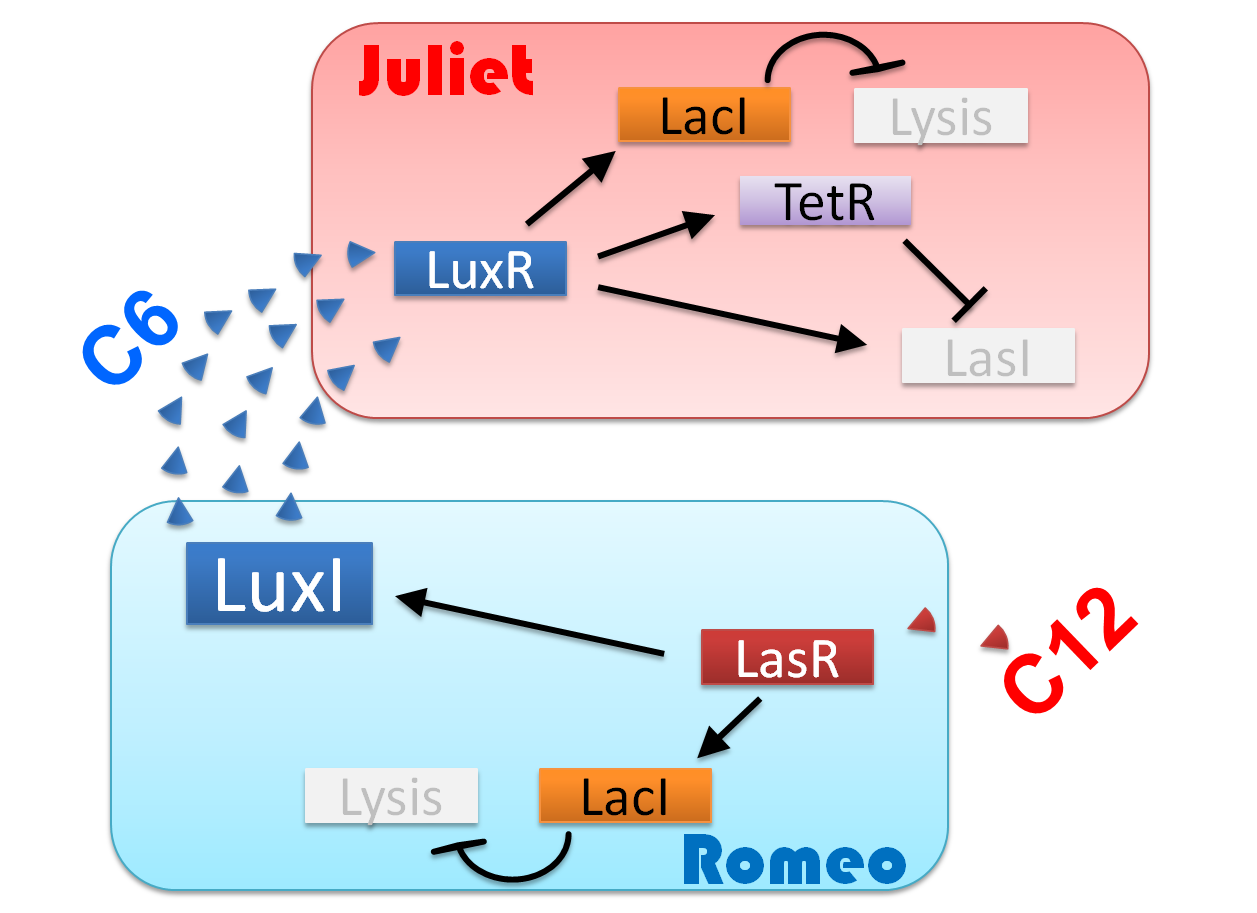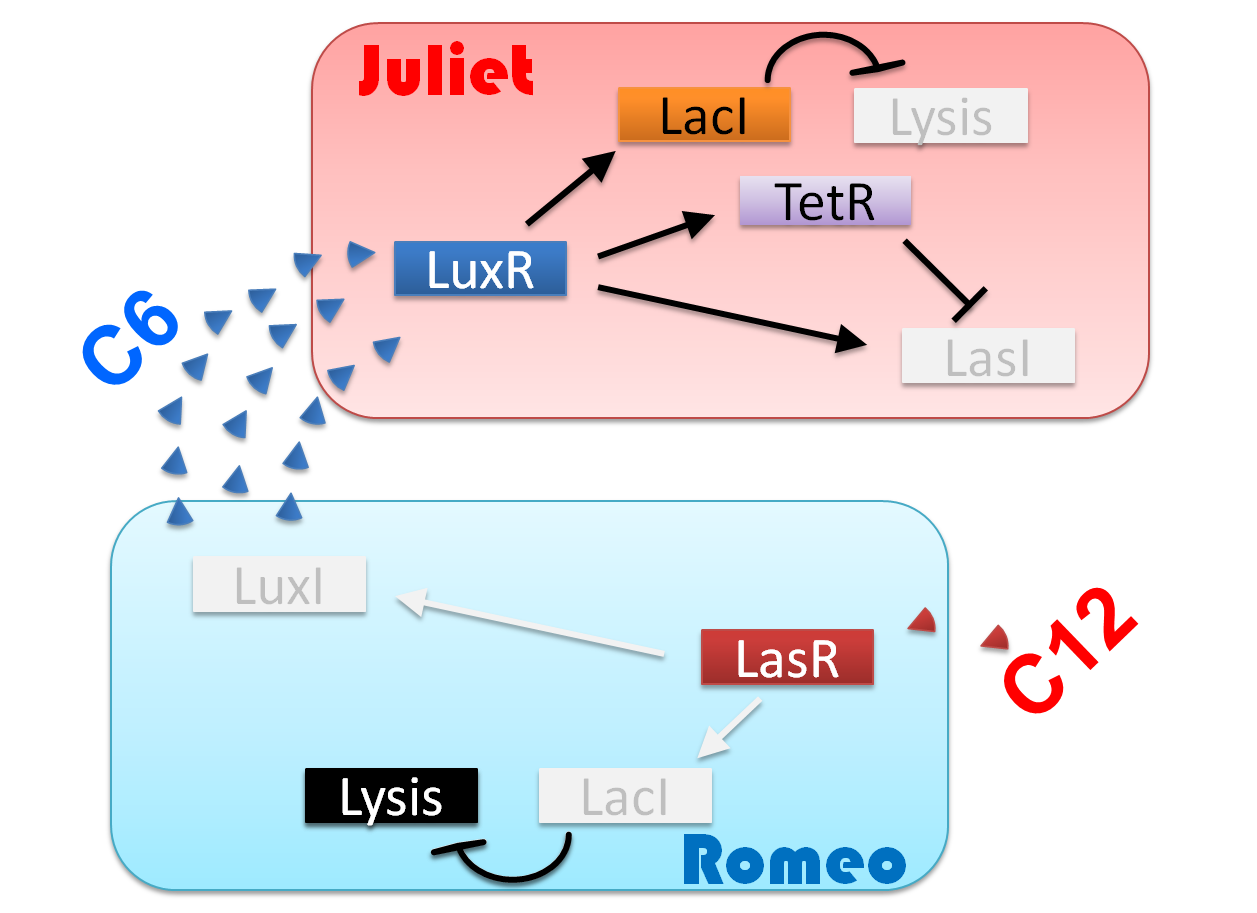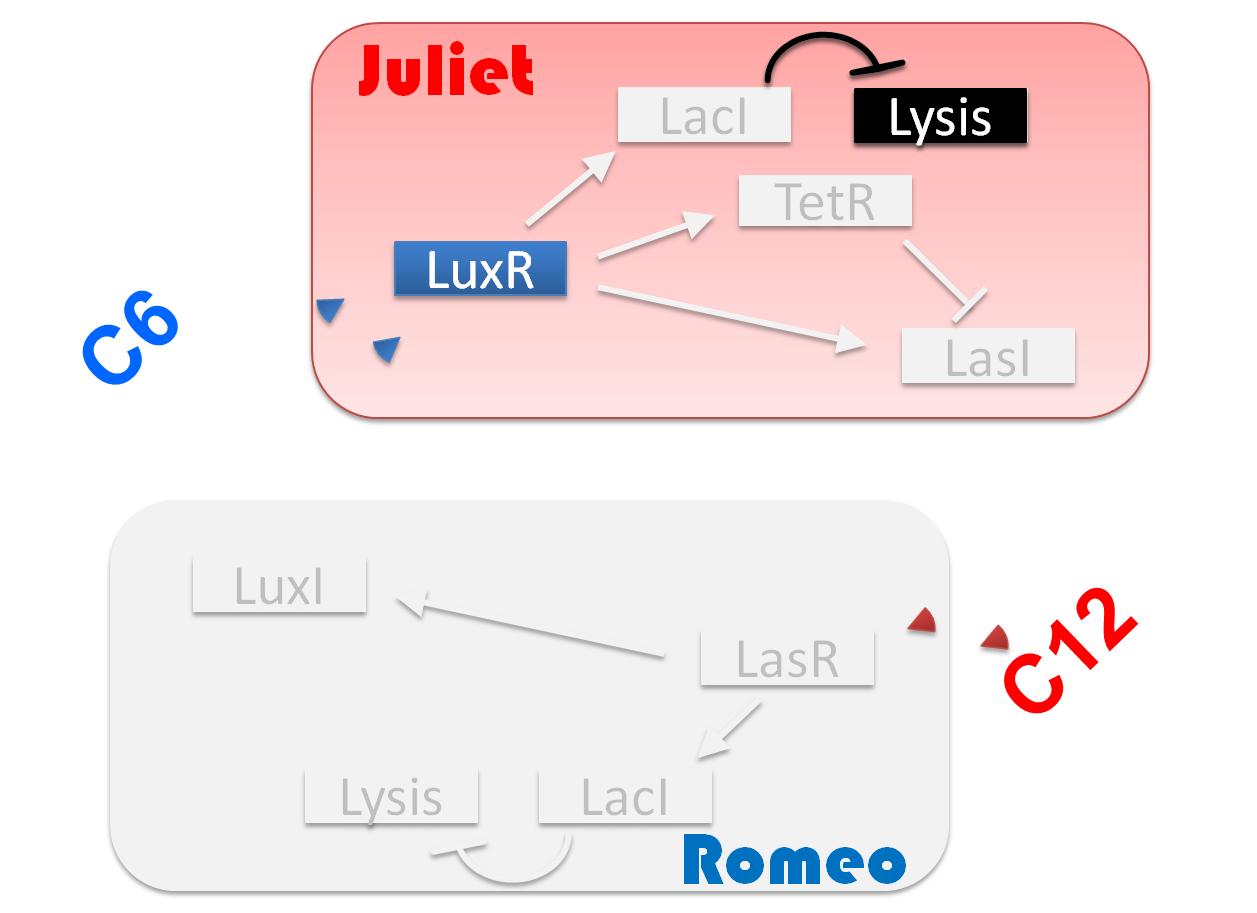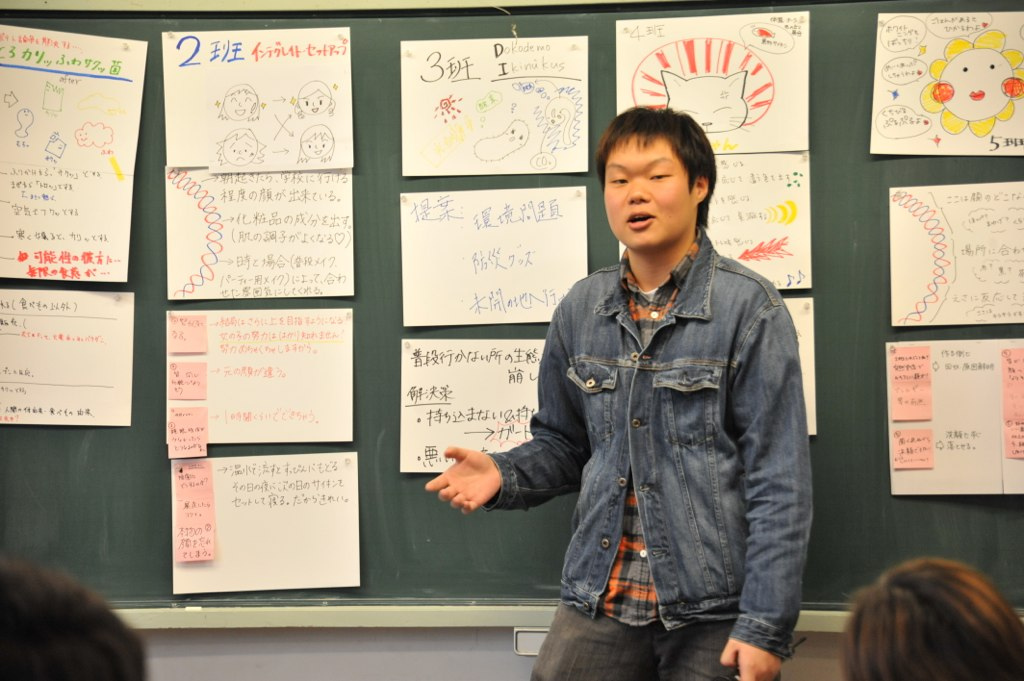Ⅰ cell-cell communication
"Romeo and Juliet" is the dramas by dramatist William Shakespeare of England. The stage is city Verona, Italy in the 14th century. Romeo met Juliet. Two people fell in love instantly. In this project, we will recreate the love story of "Romeo and Juliet".
[Detailed descriptions for Cell-cell communication]
Ⅰ-1 story
We make our cute E.coli play “Romeo and Juliet” which is one of Shakespeare’s most famous plays. In this project, we define the signal that E.coli produce as the romantic feeling of Romeo and Juliet. In this project, we will recreate the love story of "Romeo and Juliet", by using "Cell-cell communication"
The story that we reproduce is divided into four scenes.
Click on the Scene.
Scene1

|
Scene2

|
Scene3

|
Scene4

|
(Scene 1) Romeo meets and falls in love with Juliet. Once the love between two people stimulates each other, they become deeply attached and cannot live without each other.
First, to represent the condition that their love stimulates each other in “Scene1 Fall in love”, we designed a positive feedback system in which the production of a signal activates the production of the other signal. [Detailed descriptions for Positive feedback system]

Fig1-6, time-dependent change of the concentrations of the two signals.
Result: Whether our circuit can reproduce “Romeo and Juliet”
To confirm the feasibility of the cell-cell communication system, we developed an ordinary differential equation model and simulated the system under typical experimental conditions. Fig1-6 shows the result of the simulation. As described below, the behavior of the signal concentration is consistent with the development of the “Romeo and Juliet” story.
In the gray area of Fig1-6, the concentration of two signals increases. It represents Scene1.[Detailed descriptions for Modeling]
(Scene 2) However, Juliet knows that their love will not be accepted by society because of family feud. To keep their relationship, Juliet plans to pretend to be dead. She takes a sleeping potion that makes her fall into a deathlike sleep.
Second, we applied a 3OC6HSL-dependent band detect system to represent “Scene2 Juliet’s deathlike sleep” by the stop of 3OC12HSL production in Juliet cell. When the concentration of 3OC6HSL reaches higher level by the positive feedback, the concentration of TetR is enough level to repress the expression of LasI, As a result, the production of 3OC12HSL is stopped though cell Juliet is alive. [Detailed descriptions for Band detect system]

Fig1-6, time-dependent change of the concentrations of the two signals.
Result: Whether our circuit can reproduce “Romeo and Juliet”
To confirm the feasibility of the cell-cell communication system, we developed an ordinary differential equation model and simulated the system under typical experimental conditions. Fig1-6 shows the result of the simulation. As described below, the behavior of the signal concentration is consistent with the development of the “Romeo and Juliet” story.
In the green area of Fig1-6, as the concentration of Romeo signals increases to the some extent, the concentration of Juliet signals starts to decline. It represents Scene2. [Detailed descriptions for Modeling]
(Scene 3) Romeo has heard of Juliet’s death without knowing the fact that Juliet is alive. Romeo decides to commit suicide by taking poison in response to Juliet’s “deathlike sleep”.
Third, to realize “Scene3 Romeo’s suicide” after Juliet fell into the deathlike sleep, we designed communication-inverter dependent suicide system in Romeo cell. When Juliet cell is in deathlike sleep, supply of 3OC12HSL is stopped though Juliet cell is alive. In the absence of 3OC12HSL, the lysis gene is expressed and Romeo cell dies.[Detailed descriptions for communication dependent suicide system]

Fig1-6, time-dependent change of the concentrations of the two signals.
Result: Whether our circuit can reproduce “Romeo and Juliet”
To confirm the feasibility of the cell-cell communication system, we developed an ordinary differential equation model and simulated the system under typical experimental conditions. Fig1-6 shows the result of the simulation. As described below, the behavior of the signal concentration is consistent with the development of the “Romeo and Juliet” story.
In the blue area of Fig1-6, lysis gene is expressed in Romeo cell in response to the decline of the concentration of Juliet signals, then the concentration of Romeo signals starts to decline. It represents Scene3.[Detailed descriptions for Modeling]
(Scene 4) Juliet awakes to find Romeo dead beside her. She decides to commit suicide in response to Romeo’s suicide. She stabs herself with a dirk.
Finally, to realize “Scene4 Juliet’s suicide” in response to Romeo’s suicide, we also designed communication-inverter dependent suicide system in Juliet cell. After the death of Romeo cell, supply of 3OC6HSL is stopped, and the expression of LacI is stopped. As a result, the lysis gene is expressed and Juliet cell dies.[Detailed descriptions for communication dependent suicide system]

Fig1-6, time-dependent change of the concentrations of the two signals.
Result: Whether our circuit can reproduce “Romeo and Juliet”
To confirm the feasibility of the cell-cell communication system, we developed an ordinary differential equation model and simulated the system under typical experimental conditions. Fig1-6 shows the result of the simulation. As described below, the behavior of the signal concentration is consistent with the development of the “Romeo and Juliet” story.
In the pink area of Fig1-6, lysis gene is expressed in Juliet cell in response to the decline of the concentration of Romeo signals, then the concentration of Juliet signals decreases further. It represents Scene4.[Detailed descriptions for Modeling]
Ⅱ PHAs Production
Ⅱ-1 Story
There is what of the famous scene of "Romeo and Juliet"
JULIET: O Romeo, Romeo! why are you Romeo? Deny your father and refuse your name;
ROMEO: Shall I hear more, or shall I speak at this?
JULIET: It's but your name that is my enemy; you are yourself, though not a Montague. O, be some other name! What's in a name? that which we call a rose By any other name would smell as sweet.
we will recreate the rose come out in the lines of the famous drama "Romeo and Juliet"
by the synthesis of PHAs.
Ⅱ-2 PHAs production
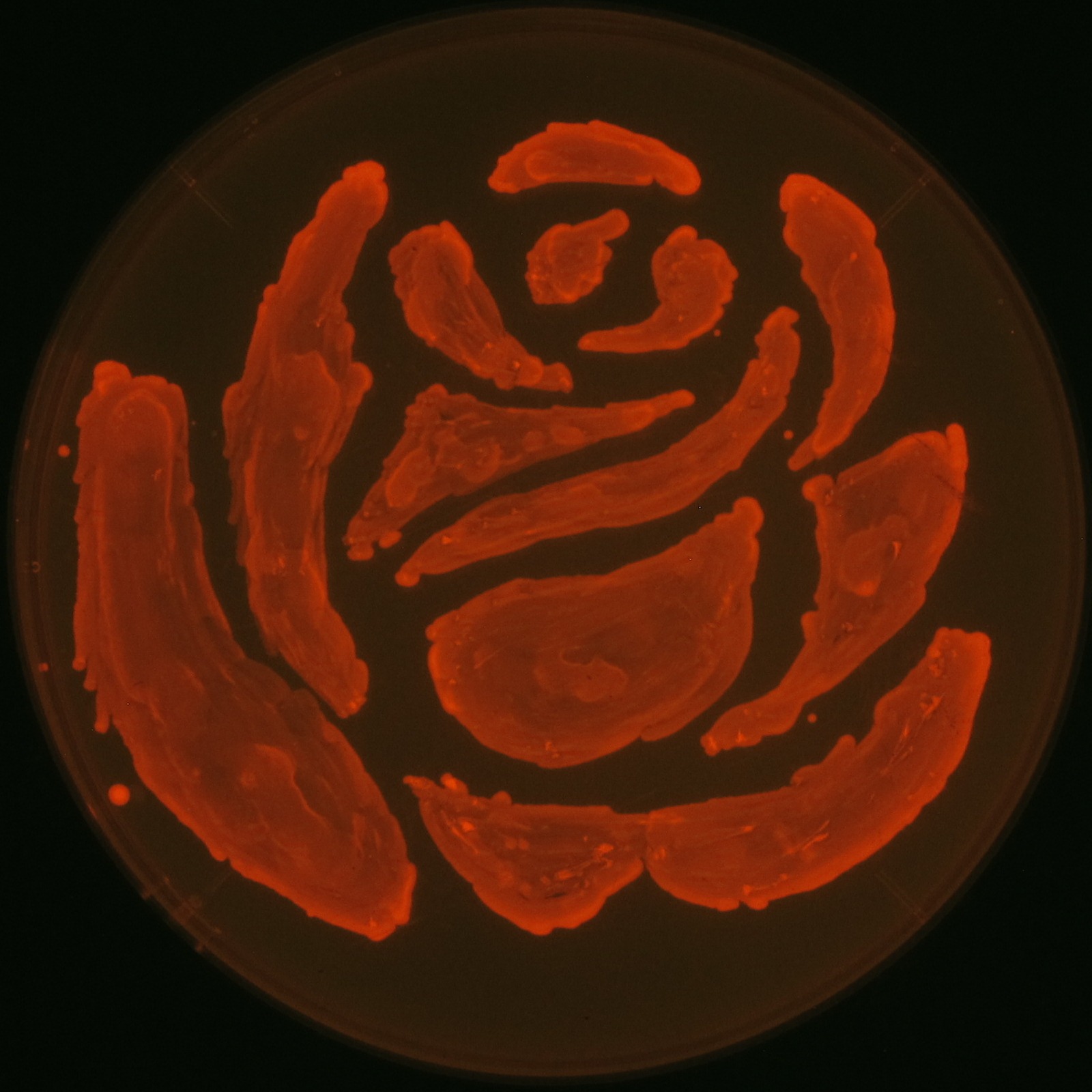
fig1-8,Rose silhouette on the LB agar plate containing Nile red.
We made a new biobrick part and succeeded synthesizing Polyhydroixyalkanoates(PHAs). This is the first Biobrick part to synthesize PHAs.
In our project, we also draw rose silhouette to produce the balcony scene of “Romeo and Juliet” by the synthesis of PHAs.[Detailed descriptions for PHAs production]
Human Practice
Taku Nakayama, and Mai Miura (members of Tokyo_Tech iGEM team) have participated in a science cafe as assistants for the event. The two members supported people who are not specialist in biology to plan an imaginary synthetic biology project, to be evaluated from public points of view, and to upgrade the project in accordance with the evaluations.
[Detailed descriptions for Human practice
]




 "
"




